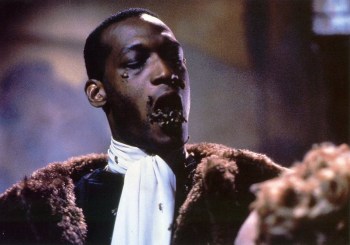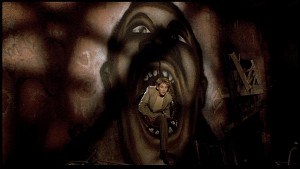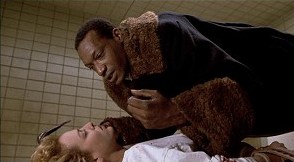 Candyman is an A movie desperately trying to break out of its B-movie body, like a 12-year-old boy wanting to prove his manhood. It is a slasher film, but it pushes and tugs and stretches to become something more. That it succeeds at all is pretty amazing.
Candyman is an A movie desperately trying to break out of its B-movie body, like a 12-year-old boy wanting to prove his manhood. It is a slasher film, but it pushes and tugs and stretches to become something more. That it succeeds at all is pretty amazing.
As a horror movie, its primary strength is its conceit: putting a monster from urban folklore (“Candyman … Candyman … Candyman … ”) into a genuinely urban setting. There’s a sense of danger and dread everywhere, created by the evocative photography of the Cabrini Green public-housing complex and the cold, culturally out-of-place Philip Glass score. The polished and carefully constructed academic music clashes with the palpable poverty and decay of the setting, revealing an unexpected rigor.
Under the movie’s trashy surface, writer/director Bernard Rose (working from a story by executive producer Clive Barker) has crafted an honest meditation on race and fear in contemporary society – from both the white and black perspectives. The unease between well-to-do whites and poor blacks envelops nearly every relationship.
There’s a great exchange between the proud mother Anne-Marie and folklore grad student Helen in a Cabrini Green apartment. “You got kids?” Anne-Marie asks. “No, but I’d love one.” It should be a throw-away line, but it pays off thematically and in the plot: Anne-Marie fears losing her child (to the gangs, or the white-run child-welfare system), and when the baby is snatched away, it’s clear that Helen’s pronouncement will haunt both of them forever.
 Candyman starts slowly and clumsily, but it picks up when the titular character – tall and dark, with a hook for a hand and dressed in a pimp-y coat with a fur collar – appears in a parking garage, and Helen blacks out. When she wakes up, she is lying in Anne-Marie’s bathroom, covered in blood. What had been grounded firmly in a realistic urban landscape has taken flight into a nightmare world of death, bees, and sweating walls covered in graffiti.
Candyman starts slowly and clumsily, but it picks up when the titular character – tall and dark, with a hook for a hand and dressed in a pimp-y coat with a fur collar – appears in a parking garage, and Helen blacks out. When she wakes up, she is lying in Anne-Marie’s bathroom, covered in blood. What had been grounded firmly in a realistic urban landscape has taken flight into a nightmare world of death, bees, and sweating walls covered in graffiti.
Rose wisely doesn’t explain the shift, and he maintains – just barely – a satisfying ambiguity about what really happens in the movie. This goes a long way toward redeeming its writing and performance trouble spots. The institutional supporting characters – the professor husband, the cop – are played as cartoons, unaided by a script with absolutely no sense of dialogue or graceful exposition. Virginia Madsen has one great, unhinged scene of (literally) naked disbelief, but her lead performance seemed stronger before Annette Bening did it better in Neil Jordan’s unappreciated In Dreams.
What sustains the movie, finally, is the possibility that Candyman doesn’t actually exist.
 Part of this is, admittedly, wishful thinking on my part. A literal, supernatural reading is more than warranted; otherwise, it’s difficult to explain the psychologist’s murder while Helen is immobilized, and how Helen got into Anne-Marie’s barricaded apartment.
Part of this is, admittedly, wishful thinking on my part. A literal, supernatural reading is more than warranted; otherwise, it’s difficult to explain the psychologist’s murder while Helen is immobilized, and how Helen got into Anne-Marie’s barricaded apartment.
But the face-value reading is less compelling than its alternative. If Candyman is real, the character of Helen is immediately diminished; it doesn’t matter who she is or what she does, because she’s nothing more than a classic slasher victim.
The possibility that Helen committed these grisly crimes herself gives the movie much of its impact. Helen is interesting because – her protestations aside – she might be capable of horrifying acts.
When Helen saves Anne-Marie’s baby, for example, the viewer’s take on the physical truth of the narrative determines one’s reaction. If Candyman exists, Helen’s action has no power; of course the heroine will rescue the child. But if one allows that perhaps Helen is a murderer, she is somewhat redeemed by her deed, and it represents a satisfying resolution to the conflict within her.
The funeral scene reinforces this perspective. It’s not clear whether the residents of Cabrini Green are there to praise and mourn Helen or spit on her grave. I’d like to think that they want to do both.


Helen’s entry into Anne-Marie’s apartment is alluded to early in the film, when Helen demonstrates the “medicine cabinet trick” to Bernadette. We can safely assume that Helen enters Anne-Marie’s apartment through Anne-Marie’s medicine chest, cracks open the bathroom door long enough to behead the dog, then kidnaps the baby and passes the baby back through the medicine chest into Ruthie-Jean’s abandoned bathroom next door. Helen then blacks-out on Anne-Marie’s bathroom floor, where we find her lying in a pool of dogblood at the beginning of the next scene.
As for the psychiatrist, we can only assume that when Helen asked at the onset (“Are these restraints REALLY necessary?”), Dr. Burke released her (unseen by the audience). The audience is deprived of many shots of Helen’s hands once she’s made the request to be released from the restraints. We only see her hands again when she envisions that Candyman is cutting her bonds. We can then assume that Helen stabbed Dr. Burke with that object he was twirling in his hands while speaking with her — a letter opener or a shiny pen. The only real unanswered question is who fed and nurtured the baby for the MONTH that Helen was in the hospital, unless of course Dr Burke’s comments about Helen receiving a month-long supply of Thorazine was only in Helen’s fevered imagination.
No. That wouldn’t work. The medicine cabinet in Ruthie-Jeans apartment opens into the Candyman’s lair -which is apparently another abandoned apartment or else a mechanical space or something. Not Anne-Marie’s apartment. Her apartment, after all, and all the other “identical” apartments in the housing project, can be assumed to have only one bathroom. So her apartment would be accessed through the medicine cabinet of yet another apartment.
However, a reading wherein Helen is the kidnapper fails, because then who cares for baby Anthony while Helen was in the hospital for a month (wasn’t it three month?)? Candyman is shown during that time feeding Anthony blood that he drips from his hook-stump. So he has to be a literal and real character, even if it one who only exists so long as belief in him exists, hence the reason that, in order to succumb to him, Helen must allow Candyman to kill her. Remember that he invites her to “be his victim.”
Candyman only exists and can only harm you if you give him the power to do so -by believing in him. Perhaps Anne-Marie did not believe in Candyman, but came to only when Helen delivered her baby back to her after he had been missing for several weeks, a time during which Helen could not have cared for him, necessitating the actual existence of Candyman.